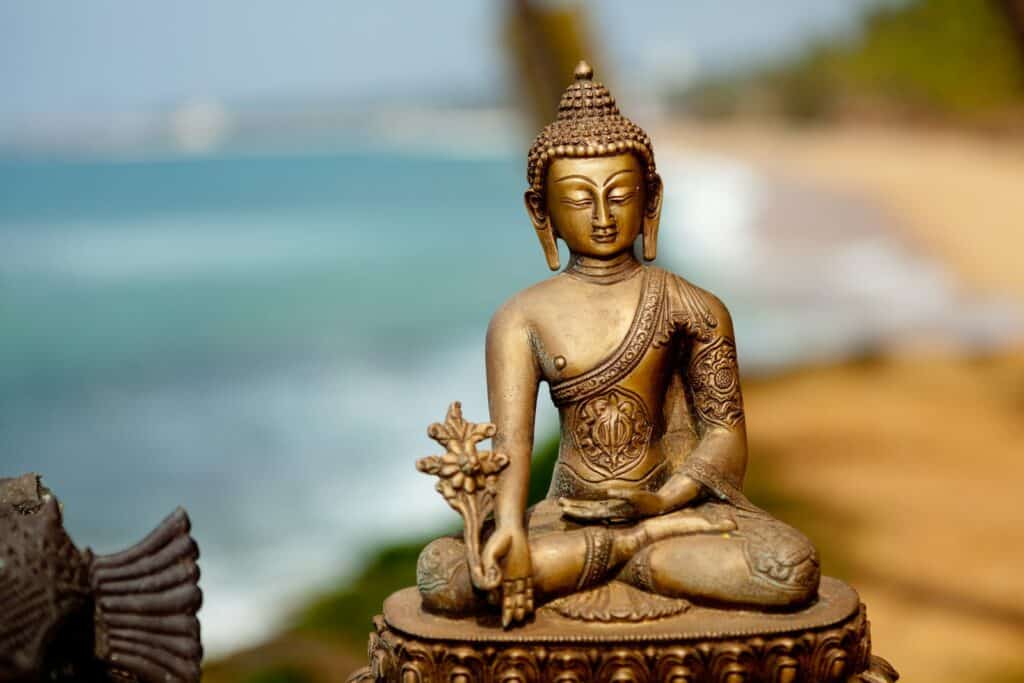The Four Noble Truths are foundational to the Buddha’s teachings. Siddhartha Gautama, also known as the Buddha, discovered the Four Noble Truths during his quest for enlightenment. The Four Noble Truths are a way of understanding the nature of suffering and how to overcome it.
The first Noble Truth is the truth of suffering. According to the Buddha, suffering is an inherent part of life. It is caused by our attachment to things and our desire for things to be different than they are. The second Noble Truth is the truth of the cause of suffering, which is our craving and attachment to things. The third Noble Truth is the truth of the cessation of suffering, which is the end of craving and attachment. The fourth Noble Truth is the truth of the path leading to the end of suffering, the Eightfold Path.
The Four Noble Truths
The Four Noble Truths are the foundation of Buddhist teachings. They are considered to be the core principles of Buddhism and were first taught by the Buddha. The Four Noble Truths are:
1. There is Suffering (Dukkha)
The first noble truth is Dukkha, which means suffering or dissatisfaction. The Buddha taught that suffering is an inherent part of life. Everyone experiences pain, illness, aging, and death. Dukkha is not limited to physical suffering but also includes mental and emotional suffering. The Buddha believed that recognizing the existence of Dukkha is the first step towards liberation.
2. There is a Cause of Suffering (Samudaya)
The second noble truth is Samudaya, which means the cause of suffering. The Buddha believed that the root of suffering is craving or desire. People always seek pleasure and avoid pain, but this desire leads to suffering. The Buddha taught us that we should learn to recognize and let go of our desires.
3. There is an End to Suffering (Nirodha)
The third noble truth is Nirodha, which means the end of suffering. The Buddha taught that it is possible to end suffering by letting go of our desires. The end of suffering is called Nirvana. Nirvana is not a place but a state of mind. It is a state of perfect peace and happiness.
4. There is a Path (Magga)
The fourth noble truth is Magga, which means the path to the end of suffering. The Buddha taught that the path to the end of suffering is the Eightfold Path. The Eightfold Path consists of Right View, Right Thought, Right Speech, Right Action, Right Livelihood, Right Effort, Right Concentration, and Right Mindfulness. The Eightfold Path is a guide to living a life free from suffering.
The Four Noble Truths are the foundation of Buddhist teachings. They teach that suffering is an inherent part of life, and the cause of suffering is craving or desire. The end of suffering is possible by letting go of our desires and following the Eightfold Path. The Four Noble Truths are the key to understanding the nature of reality and achieving liberation from suffering.
The First Noble Truth: Dukkha
The First Noble Truth is the foundation of Buddhism, and it states that life is filled with suffering, known as Dukkha. Dukkha is a complex term that encompasses many forms of suffering, including stress, pain, sickness, aging, death, loss, anxiety, unhappiness, grief, longing, confusion, disappointment, and unsatisfying experiences.
The Buddha taught that suffering is an inescapable part of life and that all beings are subject to it. He also taught that suffering arises from craving and attachment and that the only way to end suffering is to eliminate these causes.
Dukkha can be categorized into three main types:
- Physical suffering, such as pain, illness, and aging.
- Emotional suffering, such as anxiety, depression, and grief.
- Existential suffering, such as the feeling of emptiness, confusion, and lack of purpose.
The Buddha believed that all beings experience suffering, regardless of their social status, wealth, or power. He taught that the root cause of suffering is desire and attachment and that by eliminating these causes, one can achieve liberation from suffering.
In summary, the First Noble Truth is the recognition that suffering is an inherent part of life and that all beings are subject to it. By understanding the nature of suffering and its causes, one can begin to take steps towards liberation from suffering.
The Second Noble Truth: Samudaya
The Second Noble Truth, Samudaya, teaches that the cause of suffering is craving, desire, and ignorance. According to Buddhism, suffering arises from our attachment to things that are impermanent and constantly changing.
Craving, also known as Tanha, is the desire for pleasure and the avoidance of pain. It is the root of all suffering, as it leads to attachment and grasping. When we crave something, we become attached to it, and when we are unable to obtain it, we suffer.
Desire, or greed, is the intense longing for something. It is the result of our attachment to pleasure and the fear of pain. When we desire something, we become consumed by it, and our thoughts and actions are driven by it.
Ignorance, or Avijja, is the lack of understanding of the true nature of things. It is the belief that things are permanent and unchanging, when in reality, everything is impermanent and constantly changing. Ignorance leads to attachment and craving, which in turn leads to suffering.
To overcome suffering, we must recognize the causes of our suffering and work to eliminate them. We must let go of our attachment to things and recognize the impermanence of all things. We must also cultivate wisdom and understanding of the true nature of things.
In conclusion, the Second Noble Truth teaches that the cause of suffering is craving, desire, and ignorance. To overcome suffering, we must recognize and eliminate these causes. By cultivating wisdom and understanding, we can let go of our attachment to things and find true happiness and peace.
The Third Noble Truth: Nirodha
The Third Noble Truth is Nirodha, which means the end of suffering. It is the realization that suffering can be brought to an end. According to the Buddha, suffering arises from craving and attachment, and the way to end suffering is to eliminate craving and attachment.
The cessation of suffering is not a temporary state but a permanent one. It is not just the absence of suffering but a state of complete peace and happiness. The Buddha described this state as “unconditioned” or “unborn” because it is not dependent on any external conditions.
The Third Noble Truth is the solution to the problem of suffering. It offers hope that suffering can be overcome and that true happiness is possible. The Buddha taught that the way to end suffering is to follow the Eightfold Path, which is the Fourth Noble Truth.
The Eightfold Path is a set of guidelines that can help one to eliminate craving and attachment and achieve the state of Nirodha. It includes Right View, Right Intention, Right Speech, Right Action, Right Livelihood, Right Effort, Right Mindfulness, and Right Concentration.
The Third Noble Truth emphasizes the importance of understanding the nature of suffering and the possibility of its cessation. It offers a way out of the cycle of suffering and rebirth and provides a path to true happiness.
The Fourth Noble Truth: Magga
The Fourth Noble Truth of Buddhism is Magga, which means “path” or “way.” It is the Eightfold Path that offers a way for Buddhists to overcome suffering and achieve enlightenment. The Eightfold Path is a set of guidelines that cover all aspects of life and are not to be mastered one at a time but practiced all at once.
The Eightfold Path is often referred to as the Noble Eightfold Path. It consists of the following eight practices:
- Right Understanding: Understanding the Four Noble Truths and the nature of reality.
- Right Intention: Having the right intentions, such as non-harming, goodwill, and compassion.
- Right Speech: Speaking truthfully and kindly, avoiding gossip and divisive speech.
- Right Action: Acting in ways that do not harm others, such as refraining from killing, stealing, and sexual misconduct.
- Right Livelihood: Earning a living in a way that is ethical and does not harm others.
- Right Effort: Making an effort to cultivate wholesome qualities and overcome unwholesome ones.
- Right Mindfulness: Being mindful of one’s thoughts, feelings, and actions, and staying present in the moment.
- Right Concentration: Cultivating a focused and concentrated mind through meditation and other practices.
These practices are interdependent and reinforce each other. For example, practicing Right Speech can help one cultivate Right Intention, and practicing Right Mindfulness can help one cultivate Right Concentration.
The Eightfold Path is not a set of strict rules or commandments, but rather a flexible and adaptable guide that can be applied to different situations and contexts. It is a path of self-discovery and self-improvement that requires effort, patience, and perseverance.
In conclusion, the Fourth Noble Truth of Buddhism is Magga, the Eightfold Path. It is a path that offers a way for Buddhists to overcome suffering and achieve enlightenment. The Eightfold Path consists of eight practices that cover all aspects of life and are interdependent and reinforce each other. By following the Eightfold Path, Buddhists can cultivate wholesome qualities and overcome unwholesome ones, and ultimately attain liberation from suffering.
Buddhist Teachings on the Four Noble Truths
The Four Noble Truths are considered the foundation of Buddhist teachings. They outline the nature of existence and the path to liberation from suffering. This section will explore the teachings on the Four Noble Truths in Buddhism, including Buddha’s teachings, Theravada teachings, and Mahayana teachings.
Buddha’s Teachings on the Four Noble Truths
According to Buddhist tradition, the Buddha taught the Four Noble Truths in his first sermon after attaining enlightenment. The first truth is the truth of suffering (dukkha), which refers to the unsatisfactory nature of existence. The second truth is the truth of the cause of suffering (samudaya), which is craving or attachment. The third truth is the truth of the cessation of suffering (nirodha), which is the end of craving and attachment. The fourth truth is the truth of the path leading to the cessation of suffering (magga), which is the Eightfold Path.
The Four Noble Truths are sometimes compared to a medical diagnosis and treatment plan. The first truth identifies the problem, the second truth identifies the cause of the problem, the third truth offers hope for a cure, and the fourth truth provides the treatment plan.
Theravada Teachings on the Four Noble Truths
Theravada Buddhism emphasizes the individual’s path to enlightenment through meditation and insight. The Four Noble Truths are central to Theravada teachings, and the Eightfold Path is seen as the means to achieve liberation from suffering.
Theravada teachings emphasize the importance of developing wisdom and insight through meditation. The ultimate goal is to achieve nibbana (nirvana), which is the state of liberation from suffering and the cycle of rebirth.
Mahayana Teachings on the Four Noble Truths
Mahayana Buddhism emphasizes the importance of compassion and love in addition to wisdom and insight. The Four Noble Truths are seen as the foundation of the path to enlightenment, but Mahayana teachings expand on this foundation to include the development of compassion and the aspiration to help others achieve liberation from suffering.
Mahayana teachings emphasize the concept of non-attachment, which is the idea that suffering arises from attachment to things that are impermanent. The ultimate goal is to achieve Buddhahood, which is the state of perfect enlightenment and the ability to help others achieve liberation from suffering.
In summary, the Four Noble Truths are the foundation of Buddhist teachings, outlining the nature of existence and the path to liberation from suffering. Buddha’s teachings, Theravada teachings, and Mahayana teachings all emphasize the importance of developing wisdom and insight through meditation, but Mahayana teachings also emphasize the importance of compassion and love. Non-attachment is a key concept in both Theravada and Mahayana teachings, and the ultimate goal is to achieve liberation from suffering and the cycle of rebirth.
Conclusion
In conclusion, the Four Noble Truths are the cornerstone of Buddhism, representing the fundamental teachings of the Buddha. These truths identify the unsatisfactory nature of existence, identify its cause, postulate a state in which suffering and its causes are absent, and set forth a path to that state.
The Four Noble Truths offer a path towards happiness, which is achieved through the cessation of craving and attachment. Buddhism teaches that the ego is an illusion and that reality is impermanent and constantly changing. The Four Noble Truths are supported by science, literature, and technology, which have all contributed to a deeper understanding of the nature of suffering and the path towards liberation.
The Four Noble Truths are summarized as follows: Life is suffering, the cause of suffering is craving, the end of suffering comes with an end to craving, and there is a path which leads one away from craving and suffering. These truths are often listed in various companions, summaries, and archives, making them easily accessible to anyone interested in learning more about Buddhism.
Overall, the Four Noble Truths serve as a guide for those seeking to understand the nature of existence and find a path towards liberation from suffering. While they may seem simple on the surface, the Four Noble Truths offer a profound understanding of the human experience and provide a roadmap for achieving lasting peace and happiness.























